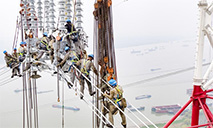Community life circles offer convenience to local residents in China’s growing cities

Photo shows a basketball court beside a 14-km pedestrian pathway next to a river in Baoshan district, Shanghai. (Photo/Wang Chu)
In recent years, multiple cities in China have started building 15-minute community life circles, which attempt to ensure that within a 15-minute walk, local residents will be able to access various types of public services related to working, living, travelling, elderly care and studying.
Caoyang New Village is well-known in Shanghai. Built in 1951, it was China’s first new village for workers, where more than 200 role model workers and advanced workers once lived. As the local population expanded, the village faced an arduous task in embracing the latest innovations.
To start with, the village focused on the renovation of old residential communities and the upgrading of public facilities located in adjacent areas. Connections were also built between several parks in the locality for people to conveniently enjoy outdoor recreation activities. Moreover, public facilities were established to enrich the cultural lives of local residents, which created a beautiful and hospitable living space for people residing in the village.
Nowadays, residents at a local residential community in the village can reach a park in the south within two-minutes’ walking distance and a service center responsible for Party-related affairs and mass work in the north can meanwhile be reached within a three-minutes’ walk.
Caoyang New Village is expected to continue building more 15-minute community life circles, further strengthening public facilities, and striving to pursue high-quality development and create a livable living space for local residents, thus further increasing people’s sense of personal well-being, satisfaction and happiness, according to an official based in the neighborhood.

Photo shows citizens reading inside a reading room that is open 24 hours a day in Chengdu, southwest China’s Sichuan Province. (Photo/Liu Guoxing)
Since 2019, fifteen neighborhoods in Shanghai have joined the campaign for building 15-minute community life circles. Currently, about 180 projects have been completed under the campaign’s framework.
According to a master plan for 2035 released by Shanghai, the city will promote 15-minute community life circles to become basic units in public resource allocation and social governance, where basic public facilities and services in such areas as elderly care, healthcare, education, business, transportation, culture and sports will all be made conveniently available.
Not only Shanghai but other Chinese cities like Beijing, Wuhan and Guangzhou are also building 15-minute community life circles, or even 5- or 10-minute community life circles based on their own plans.
China’s urbanization rate increased to 64.72 percent in 2021, which represents a significant rise from 17.9 percent in 1978, and with its population of permanent urban dwellers now surpassing 900 million in all.
“China’s urbanization process entered its second half in 2010, with service becoming a major aspect in urbanization and convenient living for the people, which is a major characteristic of this era,” said Li Zhigang, dean of the School of Urban Design at Wuhan University.
“A community life circle provides a scenario that is convenient, comfortable and harmonious, and it serves people of all age groups,” said Li.

Photo shows elderly citizens, including those living alone and those who face difficulties living a normal life, enjoying a free lunch at a canteen located inside a neighborhood in Nankai district, north China’s Tianjin Municipality. Thanks to the implementation of an elderly care project, elderly citizens living in the area can enjoy free lunches at the canteen for a one-year period. (Photo/Wang Yinghao)
China will carry out a new type of people-centered urbanization that will improve the quality of cities and guarantee a high-quality life for people who live in cities, according to the country’s 14th Five-Year Plan (2021-2025).
However, when promoting urban construction and building community life circles, there are still many problems that a large number of cities encounter, including an insufficient supply and imbalanced distribution of infrastructure, inadequate elderly-care facilities that cannot cope with challenges brought by an aging population, and the differentiated needs of citizens, among other concerns, according to Jin Ge, a fellow researcher with Peking University.
“There is a large economic development gap between different regions in the country, as well as disparities in the strengths between different cities. Because each individual city has its own unique history, culture, and strengths in infrastructure, we need to make sure that the construction of community life circles suits local conditions and can be carried out in an orderly manner,” said Jin.
Photos
Related Stories
- Community governance pools wisdom from residents
- Narrow alley, broad minds
- Xi Jinping on building community of life for man, nature
- E China's community organizes catering team to help seniors citizens in COVID-19 fight
- Woman shot by stray bullet from nearby shooting range
- Security guard takes care of pangolin found in residence community
- China to Open up Gated Residential Communities to Public
- China encourages community consultation to solve disputes
- China Voice: China assumes larger role in building ‘community of common destiny’
- China vows closer eye on convicts in community service programs
Copyright © 2022 People's Daily Online. All Rights Reserved.










